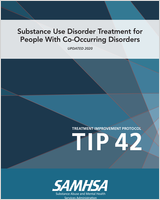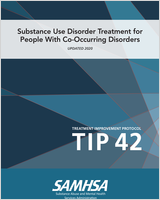NCBI Bookshelf. A service of the National Library of Medicine, National Institutes of Health.
This publication is provided for historical reference only and the information may be out of date.
This TIP, Substance Abuse Treatment for Persons With Co-Occurring Disorders, revises TIP 9, Assessment and Treatment of Patients With Coexisting Mental Illness and Alcohol and Other Drug Abuse. The revised TIP provides information about new developments in the rapidly growing field of co-occurring substance use and mental disorders and captures the state-of-the-art in the treatment of people with co-occurring disorders. The TIP focuses on what the substance abuse treatment clinician needs to know and provides that information in an accessible manner. The TIP synthesizes knowledge and grounds it in the practical realities of clinical cases and real situations so the reader will come away with increased knowledge, encouragement, and resourcefulness in working with clients with co-occurring disorders.
Contents
- Acknowledgments
- What Is a TIP?
- Consensus Panel
- KAP Expert Panel and Federal Government Participants
- Foreword
- Executive Summary
- 1 Introduction
- 2 Definitions, Terms, and Classification Systems for Co-Occurring Disorders
- 3 Keys to Successful Programming
- 4 Assessment
- 5 Strategies for Working With Clients With Co-Occurring Disorders
- 6 Traditional Settings and Models
- 7 Special Settings and Specific Populations
- 8 A Brief Overview of Specific Mental Disorders and Cross-Cutting Issues
- 9 Substance-Induced Disorders
- Appendix A: Bibliography
- Appendix B: Acronyms
- Appendix C: Glossary of Terms
- Appendix D: Specific Mental Disorders: Additional Guidance for the Counselor
- Appendix E: Emerging Models
- Appendix F: Common Medications for Disorders
- Appendix G: Screening and Assessment Instruments
- Appendix H: Screening Instruments
- Appendix I: Selected Sources of Training
- Appendix J: Dual Recovery Mutual Self-Help Programs and Other Resources for Consumers and Providers
- Appendix K: Confidentiality
- Appendix L: Resource Panel
- Appendix M: Cultural Competency and Diversity Network Participants
- Appendix N: Field Reviewers
Suggested citation:
Center for Substance Abuse Treatment. Substance Abuse Treatment for Persons With Co-Occurring Disorders. Treatment Improvement Protocol (TIP) Series 42. DHHS Publication No. (SMA) 05-3922. Rockville, MD: Substance Abuse and Mental Health Services Administration, 2005.
The opinions expressed herein are the views of the Consensus Panel members and do not necessarily reflect the official position of CSAT, SAMHSA, or DHHS. No official support of or endorsement by CSAT, SAMHSA, or DHHS for these opinions or for particular instruments, software, or resources described in this document are intended or should be inferred. The guidelines in this document should not be considered substitutes for individualized client care and treatment decisions.
- Risk of criminal justice system involvement among people with co-occurring severe mental illness and substance use disorder.[Int J Law Psychiatry. 2018]Risk of criminal justice system involvement among people with co-occurring severe mental illness and substance use disorder.Prince JD, Wald C. Int J Law Psychiatry. 2018 May-Jun; 58:1-8. Epub 2018 Mar 3.
- Cooperative agreement with Policy Research, Inc., to continue the National GAINS Center for People with Co-Occurring Disorders in the Justice System. Center for Substance Abuse Treatment (CSAT) and Center for Mental Health Services (CMHS), Substance Abuse and Mental Health Services Administration (SAMHSA), HHS.[Fed Regist. 1999]Cooperative agreement with Policy Research, Inc., to continue the National GAINS Center for People with Co-Occurring Disorders in the Justice System. Center for Substance Abuse Treatment (CSAT) and Center for Mental Health Services (CMHS), Substance Abuse and Mental Health Services Administration (SAMHSA), HHS.. Fed Regist. 1999 Apr 22; 64(77):19799.
- Treatment for co-occurring mental and substance use disorders in five state Medicaid programs.[Psychiatr Serv. 2007]Treatment for co-occurring mental and substance use disorders in five state Medicaid programs.Clark RE, Samnaliev M, McGovern MP. Psychiatr Serv. 2007 Jul; 58(7):942-8.
- Review Substance abuse and psychiatric disorders in HIV-positive patients: epidemiology and impact on antiretroviral therapy.[Drugs. 2006]Review Substance abuse and psychiatric disorders in HIV-positive patients: epidemiology and impact on antiretroviral therapy.Chander G, Himelhoch S, Moore RD. Drugs. 2006; 66(6):769-89.
- Review Assessment and Treatment of Patients with Coexisting Mental Illness and Alcohol and Other Drug Abuse[ 1994]Review Assessment and Treatment of Patients with Coexisting Mental Illness and Alcohol and Other Drug AbuseCenter for Substance Abuse Treatment. 1994
- Substance Abuse Treatment for Persons With Co-Occurring DisordersSubstance Abuse Treatment for Persons With Co-Occurring Disorders
Your browsing activity is empty.
Activity recording is turned off.
See more...

